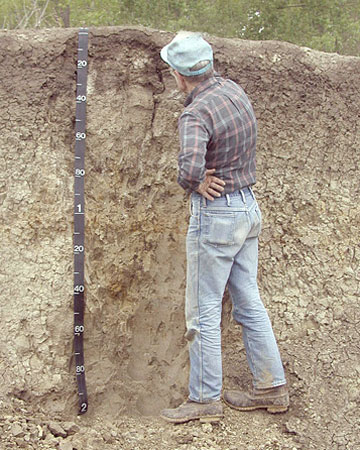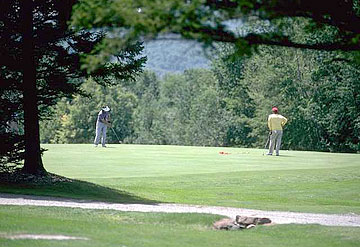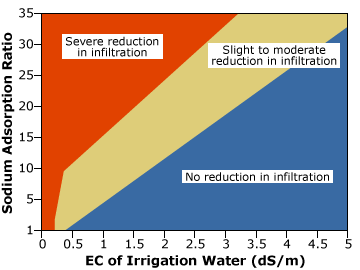- Home
- Learn about salinity
- Get to know your site
- Design a landscape
- Solve a problem
- Other information
Salinity Management Guide

Evaluating the landscape's soil
When determining whether salinity is or may become a problem for a landscape irrigated with water of elevated salinity, the soil — the medium through which water flows and in which plants grow — should be closely scrutinized.
Reviewing notes from the field
Evidence of a salinity-related problem in a landscape's soil is unlikely to be as obvious as a whitish crust on the surface of bare soil — one of the symptoms of a long-standing problem. Instead, scan field notes and photos for what's subtler: any indications that the landscape's soil has characteristics that cause water to move through it slowly. If there's one or more, then the chances of a salinity-related problem currently or eventually existing are higher. That's because residues of soluble salts in irrigation water accumulate over time nearer the roots of plants if water moves less readily through the soil. Plus, a sufficient accumulation of salts may compound the problem by further decreasing the soil's permeability.
Search your notes and photos for signs of the following:
- A high amount of clay in the soil: If the soil has a relative abundance of clay — 20% or more of its total volume — then water is apt to move through it slowly. By contrast, if the soil is composed mainly of sand — for example, 45% or more by volume — then water tends to flow through it more readily.
- A lower layer of impermeable soil: Even if water moves readily through the uppermost layer of soil, its flow may be impeded by a lower layer of impermeable soil, such as a layer in which air spaces have been filled with particles of clay, or a layer of accumulated calcium carbonate, magnesium carbonate, iron oxide or other such cementing substance.
- Compacted soil: A soil's structure — the combination or arrangement of primary particles into secondary particles or units, between which water and air move and roots grow — can be disrupted by mechanical means, such as heavy vehicles or foot traffic, or by chemical means, such as a high accumulation of salts. The resulting compaction hinders the movement of water through the soil.
Reviewing the laboratory report

As you read the laboratory's report regarding their analyses of your soil samples, pay particular attention to the findings that will help reveal a current or incipient salinity-related problem. Those include:
- Electrical conductivity of the soil extract (ECe): This is a measure of a soil's salinity.
Laboratories ascertain a soil's salinity by measuring the electrical conductivity of solution extracted from sampled soil that has been saturated with the least amount of water possible and allowed to reach equilibrium.
- Sodium adsorption ratio (SAR): This calculated ratio — a soil's concentration of soil-dispersing sodium relative to its concentrations of soil-stabilizing calcium and magnesium — reveals whether the permeability of the soil has been (or likely will be) impaired by the presence of excessive sodium.
To obtain a particular soil's SAR, the laboratory technicians extract from the soil a water solution. They next measure the solution for concentrations of sodium, calcium, and magnesium by such means as atomic absorption spectrometry. They then use these concentrations to calculate the SAR.

Chart using SAR and EC together to assess an irrigation water
If you wish to evaluate the effect of sodium on your soil's permeability, the SAR should be considered in conjunction with the irrigation water's electrical conductivity (ECw). A graph of SAR versus ECw is very helpful in this regard (see graph at left). If the irrigation water has a low ECw, which typically means the water contains relatively low concentrations of sodium-moderating calcium and magnesium, then a sodium-induced decrease in the soil's permeability may occur at a lower SAR.
- Concentrations of sodium, chloride, and boron: Soluble sodium, chloride, and boron in irrigation water pass through a landscape's soil. Depending on their concentrations and the soil's permeability, they may remain and accumulate near the surface, where sufficiently high concentrations of them may injure the roots and shoots of sensitive plants.
To determine the amounts of sodium, chloride, and boron in a landscape's soil, laboratories extract sodium, chloride, and boron in solution from a minimally saturated sample of soil and measure their concentrations.
To use the results from soil tests to assess whether it's likely your landscape has (or will eventually have) a salinity-related problem, consult the table titled Interpreting the results from salinity-related tests of soil. From that table, you can see clearly the ranges of EC, SAR, sodium, chloride, and boron that researchers consider to be low, moderate, or high, corresponding to a low, moderate, or high likelihood of a problem occurring.
| « Previous page | Next page » |